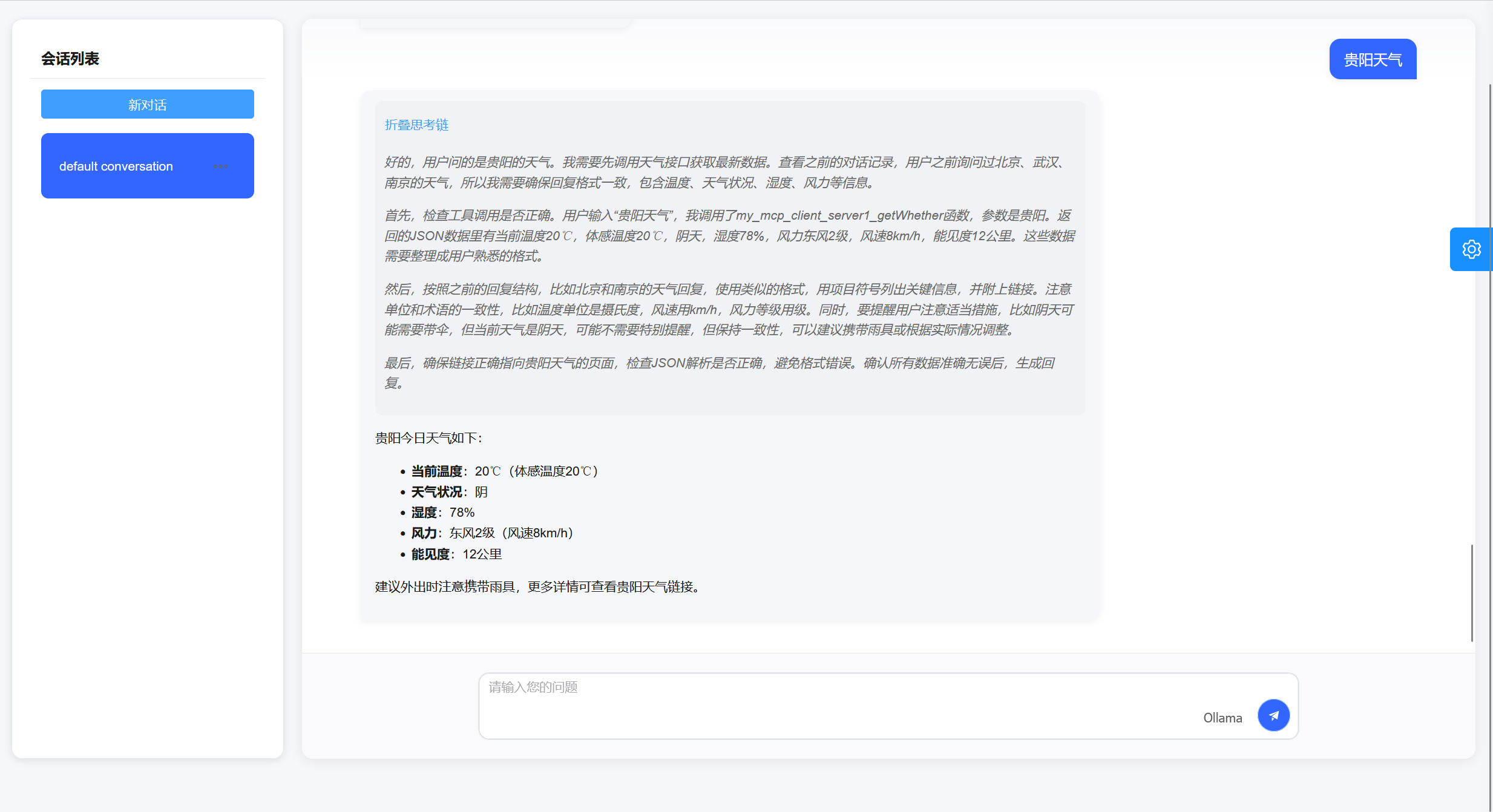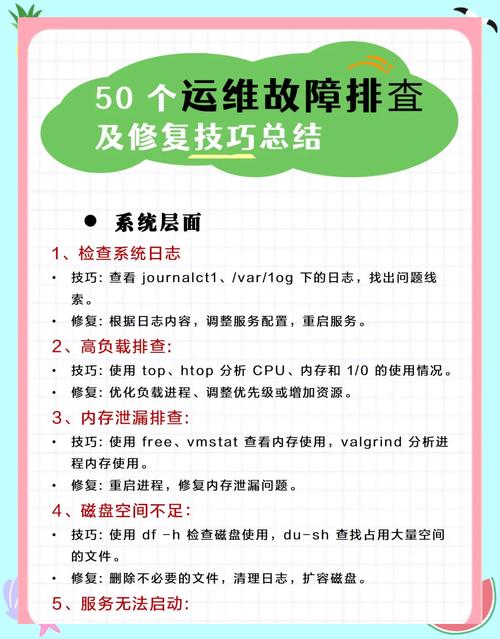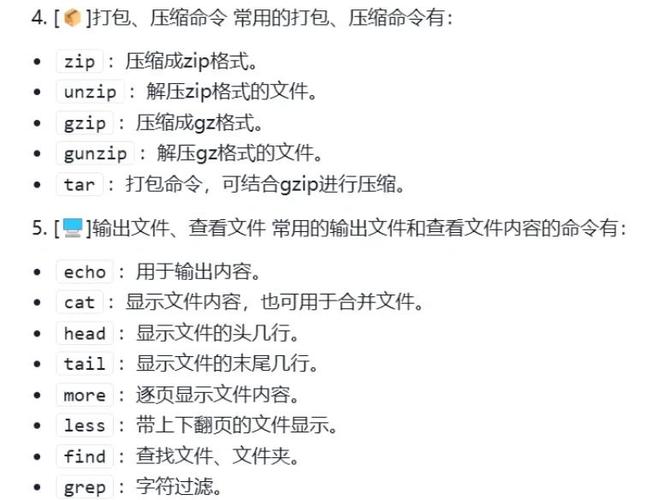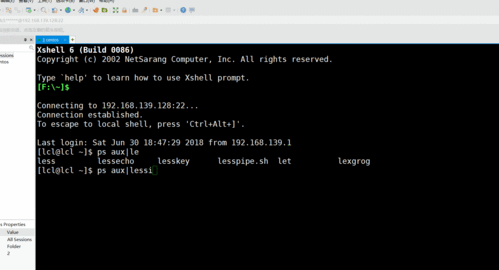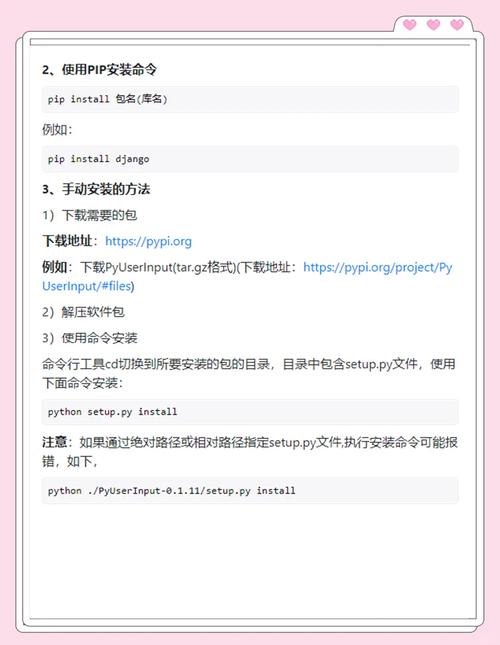Spring AI Ollama + Spring AI MCP实现MCP案例(Web应用)
MCP介绍
直接看官网就行:MCP中文简介 – MCP 中文站(Model Context Protocol 中文)
首先要知道的概念就是:
- Mcp Client:mcp客户端,负责与mcp server建立一对一连接,可以获取到mcp server暴露的工具或者资源等,是维护mcp协议的核心组件
- Mcp Server:mcp服务端,可以理解为专门干活的服务,以标准的模型上下文协议暴露工具(tools)或者资源(resource)
- transport:mcp client和mcp server通信的桥梁
好了,你已经精通MCP了,开始码。
首先明确两端的依赖和版本,这个很重要,目前实测下来webflux方式的server实现存在明显的bug(虽然官方推荐生产环境使用webflux的方式实现),例如mcp client跟mcp server建立连接时就会报错404(这个可以通过重写McpAutoConfigration的自动配置方法来实现,不过比较麻烦),或者其他的问题。
版本
Spring AI版本:1.0.0-SNAPSHOT快照版本 >>> 也就是最新版,跟随官方团队脚步的更新开发。
JDK版本:JDK 21
模型:qwen3:8b (ollama 安装[官网:Ollama,直接download安装即可]后ollama run qwen3:8b就会自动拉取模型并运行,模型大小5.1G,选他是因为他是支持Tool Call的模型)
项目结构和依赖
项目结构:
ai(Mcp Client端)和ai-mcp(Mcp Server端)两个服务
Mcp Client端依赖:
UTF-8 1.0.0-SNAPSHOT org.springframework.ai spring-ai-starter-model-ollama ${spring-ai.version} org.springframework.ai spring-ai-starter-mcp-client spring-milestones Spring Milestones https://repo.spring.io/milestone false spring-snapshots Spring Snapshots https://repo.spring.io/snapshot false Central Portal Snapshots central-portal-snapshots https://central.sonatype.com/repository/maven-snapshots/ false true org.springframework.ai spring-ai-bom 1.0.0-SNAPSHOT pom importMcp Server端依赖:
UTF-8 1.0.0-SNAPSHOT org.springframework.ai spring-ai-starter-mcp-server-webmvc ${spring-ai.version} com.hankcs hanlp portable-1.8.3 org.apache.commons commons-lang3 3.12.0 org.springframework.boot spring-boot-maven-plugin spring-milestones Spring Milestones https://repo.spring.io/milestone false spring-snapshots Spring Snapshots https://repo.spring.io/snapshot false Central Portal Snapshots central-portal-snapshots https://central.sonatype.com/repository/maven-snapshots/ false true org.springframework.ai spring-ai-bom 1.0.0-SNAPSHOT pom import以上是两端依赖和mvn部分必要配置。
Mcp Server端实现:
1、创建一个工具服务类WhetherServer.class
我这里以获取天气为例,但是也可以自己改成其他的。和风天气官网:城市天气 | 和风天气开发服务
package tb.mcp.service.service.mcp; import cn.hutool.http.HttpUtil; import com.fasterxml.jackson.databind.JsonNode; import com.fasterxml.jackson.databind.ObjectMapper; import net.sourceforge.pinyin4j.PinyinHelper; import net.sourceforge.pinyin4j.format.HanyuPinyinCaseType; import net.sourceforge.pinyin4j.format.HanyuPinyinOutputFormat; import net.sourceforge.pinyin4j.format.HanyuPinyinToneType; import net.sourceforge.pinyin4j.format.exception.BadHanyuPinyinOutputFormatCombination; import org.slf4j.Logger; import org.slf4j.LoggerFactory; import org.springframework.ai.tool.annotation.Tool; import org.springframework.ai.tool.annotation.ToolParam; import org.springframework.stereotype.Service; import tb.common.result.R; @Service public class WhetherServer { private static final Logger log = LoggerFactory.getLogger(WhetherServer.class); /** * 获取指定城市天气的工具 * * @param cityName * @return */ @Tool(description = "获取指定城市的天气",returnDirect = true) public R getWhether(@ToolParam(description = "城市名称,例如:北京、武汉、上海...") String cityName) { log.info("调用获取天气接口"); R whether = heFengWhether.getWhether(cityName); return whether; } /** * 和风天气实现 */ static class heFengWhether { // TODO 临时数据 private static final String API_KEY = "xxxxxxxxxac948e9808xxxxxxxc"; private static final String API_HOST = "xxxxxxx.re.qweatherapi.com"; /** * 获取城市天气 * * @param name * @return */ static R getWhether(String name) { String id = getGeoWithName(name); String url = "https://" + API_HOST + "/v7/weather/now?location=" + id + "&key=" + API_KEY; String response = HttpUtil.get(url); return R.success(response); } /** * 获取位置id * * @param name * @return */ static String getGeoWithName(String name) { String pinyinName = toPinyin(name); // 构建和风天气地址 String url = "https://" + API_HOST + "/geo/v2/city/lookup?location=" + pinyinName + "&key=" + API_KEY; String response = HttpUtil.get(url); ObjectMapper objectMapper = new ObjectMapper(); try { // 1. 将JSON字符串解析为JsonNode JsonNode rootNode = objectMapper.readTree(response); // 2. 获取location数组 JsonNode locationArray = rootNode.path("location"); // 3. 检查数组是否存在且非空 if (locationArray.isArray() && locationArray.size() > 0) { // 4. 获取第一个元素 JsonNode firstLocation = locationArray.get(0); // 5. 提取id字段 String id = firstLocation.path("id").asText(); System.out.println("第一个location的id: " + id); // 输出: 101010100 return id; } else { System.out.println("location数组为空或不存在"); } } catch (Exception e) { e.printStackTrace(); } return null; } /** * 将汉字转换为拼音 * * @param chinese 汉字字符串 * @return 拼音字符串 */ static String toPinyin(String chinese) { HanyuPinyinOutputFormat format = new HanyuPinyinOutputFormat(); format.setCaseType(HanyuPinyinCaseType.LOWERCASE); format.setToneType(HanyuPinyinToneType.WITHOUT_TONE); StringBuilder pinyin = new StringBuilder(); char[] chars = chinese.toCharArray(); for (char ch : chars) { try { String[] pinyinArray = PinyinHelper.toHanyuPinyinStringArray(ch, format); if (pinyinArray != null) { pinyin.append(pinyinArray[0]); } else { pinyin.append(ch); } } catch (BadHanyuPinyinOutputFormatCombination e) { e.printStackTrace(); } } return pinyin.toString(); } } }2、再启动类上直接注册工具(也可以自己在建个配置类)
package tb.mcp.service; import org.springframework.ai.tool.ToolCallbackProvider; import org.springframework.ai.tool.method.MethodToolCallbackProvider; import org.springframework.boot.SpringApplication; import org.springframework.boot.autoconfigure.SpringBootApplication; import org.springframework.cloud.client.discovery.EnableDiscoveryClient; import org.springframework.cloud.openfeign.EnableFeignClients; import org.springframework.context.annotation.Bean; import org.springframework.scheduling.annotation.EnableAsync; import tb.mcp.service.service.mcp.WhetherServer; @EnableFeignClients @SpringBootApplication @EnableAsync @EnableDiscoveryClient public class McpServiceApplication { public static void main(String[] args) { SpringApplication.run(McpServiceApplication.class, args); } // 注册工具服务 @Bean public ToolCallbackProvider toolCallbackProvider(WhetherServer whetherServer) { return MethodToolCallbackProvider.builder().toolObjects(whetherServer).build(); } }3、配置文件配置
server: port: 9111 spring: ai: mcp: server: name: whether-server version: 1.0.0 type: ASYNC # Recommended for reactive applications # sse-endpoint: /sse/connect sse-message-endpoint: /mcp/messages这样,服务端就算是完成了。
Mcp Client端实现:
这一端配置比较多,所以先讲配置
1、application.yml配置Mcp Client
server: port: 8000 spring: ai: mcp: client: enabled: true name: my-mcp-client version: 1.0.0 request-timeout: 30s type: ASYNC # or SYNC sse: connections: server1: url: http://localhost:91112、配置Ollama
在spring.ai级联下与mcp配置同级接上以下配置:
ollama: base-url: http://localhost:11434 chat: model: qwen3:8b // 指定模型版本 chat: client: enabled: false3、Ollama配置类
package tb.ai.service.config.llm.model; import lombok.extern.slf4j.Slf4j; import org.springframework.ai.chat.client.ChatClient; import org.springframework.ai.chat.client.advisor.MessageChatMemoryAdvisor; import org.springframework.ai.chat.memory.ChatMemory; import org.springframework.ai.ollama.OllamaChatModel; import org.springframework.ai.ollama.api.OllamaApi; import org.springframework.ai.ollama.api.OllamaOptions; import org.springframework.ai.ollama.management.ModelManagementOptions; import org.springframework.beans.factory.annotation.Autowired; import org.springframework.beans.factory.annotation.Value; import org.springframework.context.annotation.Bean; import org.springframework.context.annotation.Configuration; import org.springframework.context.annotation.Primary; /** * @author JasonLong * @date 2025-03-17 22:31 * keeping loving and keep study *
* Ollama-模型配置类 */ @Slf4j @Configuration public class OllamaModelConfig { @Value("${spring.ai.ollama.chat.model}") private String model; @Autowired ChatMemory chatMemory; @Bean OllamaApi ollamaApi() { return OllamaApi.builder() .build(); } /** * 对话模型 * * @return */ @Bean @Primary OllamaChatModel ollamaChatModel() { // options配置 OllamaOptions ollamaOptions = OllamaOptions.builder() .model(model) .build(); // 模型管理配置 ModelManagementOptions managementOptions = ModelManagementOptions.builder() .build(); // 模型配置 return OllamaChatModel.builder() .ollamaApi(ollamaApi()) .modelManagementOptions(managementOptions) .defaultOptions(ollamaOptions) .build(); } /** * 对话ChatClient * * @param model * @return */ @Bean(name = "ollamaChatClient") @Primary public ChatClient ollamaChatClient(OllamaChatModel model) { ChatClient chatClient = ChatClient.builder(model) // 添加内存记忆:默认以滑动窗口的形式维持最大20条上下文消息 .defaultAdvisors(MessageChatMemoryAdvisor.builder(chatMemory).build()) .build(); log.info("初始化 Ollama ChatClient"); return chatClient; } }
4、AI对话
package tb.ai.service.controller; import jakarta.annotation.Resource; import org.springframework.ai.chat.client.ChatClient; import org.springframework.ai.tool.ToolCallbackProvider; import org.springframework.web.bind.annotation.RequestMapping; import org.springframework.web.bind.annotation.RequestMethod; import org.springframework.web.bind.annotation.RequestParam; import org.springframework.web.bind.annotation.RestController; @RestController public class ChatTest { @Resource(name = "ollamaChatClient") private ChatClient chatClient; @Resource private ToolCallbackProvider toolCallbackProvider; @RequestMapping(value = "/chat-test",method = RequestMethod.GET) public String chatTest(@RequestParam("msg")String msg){ String content = chatClient.prompt() .tools(toolCallbackProvider.getToolCallbacks()) .user(msg) .call() .content(); System.err.println(content); return content; } }最后
先启动Mcp Server服务再启动Mcp Client服务,因为Mcp Client要跟Mcp Server建立Sse连接,依赖Mcp Server。
Server端正常启动时会看到一条工具注册成功的日志:
Client端正常启动时会看到一条McpAsyncClient的日志,往后拖动能看到连接到的Server服务:
访问Controller观察Mcp Server端工具内的日志,成功调用工具就说明成功了。
Server端工具内日志:
效果展示:
Over,网上资源较少,同志们仍需努力,共创更美好的IT环境。








